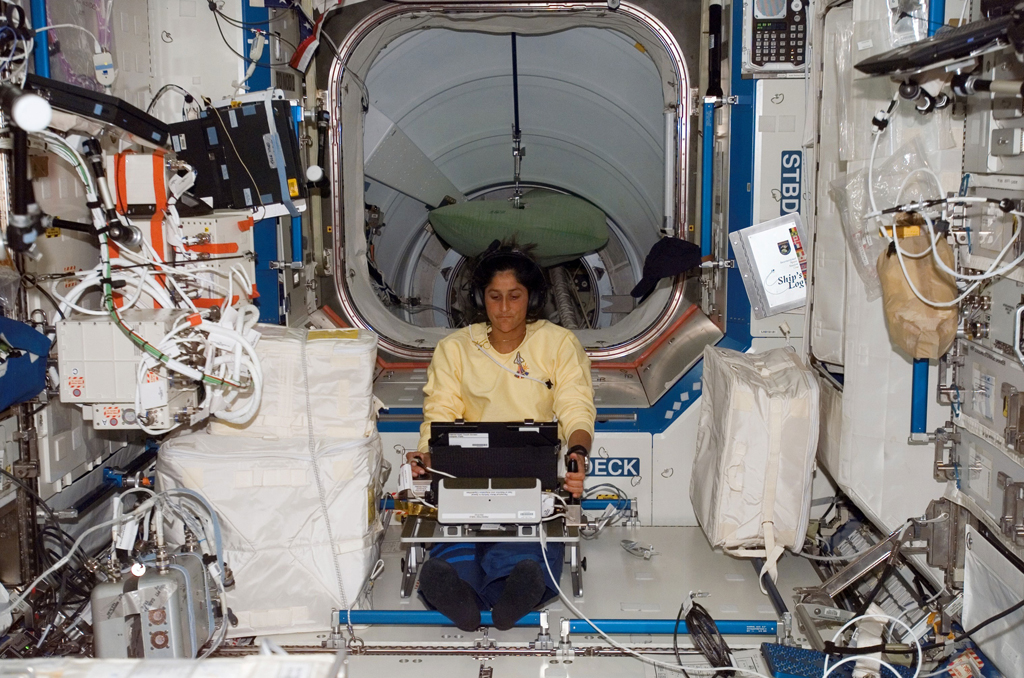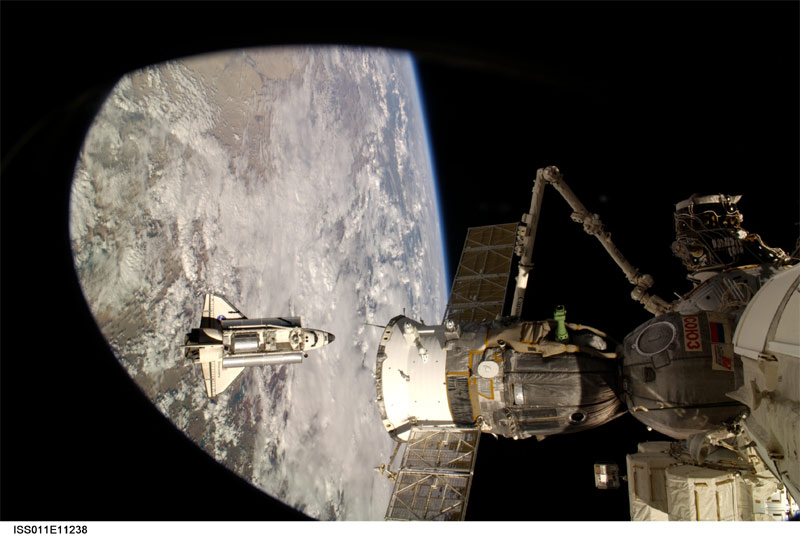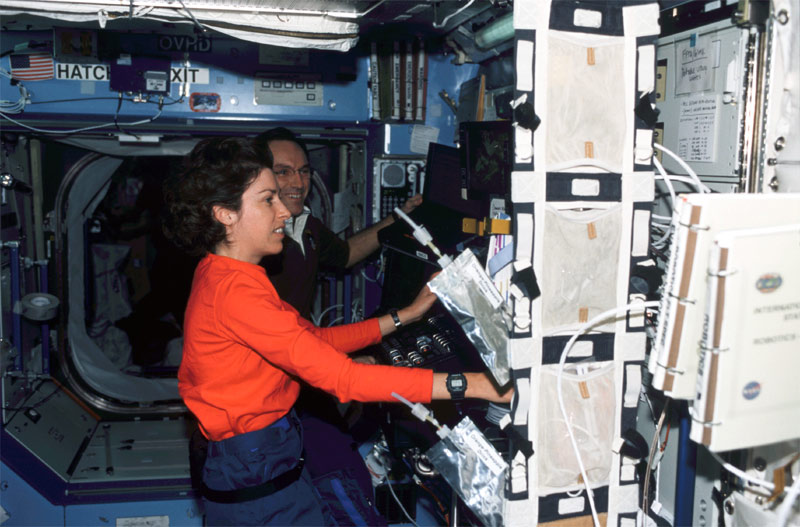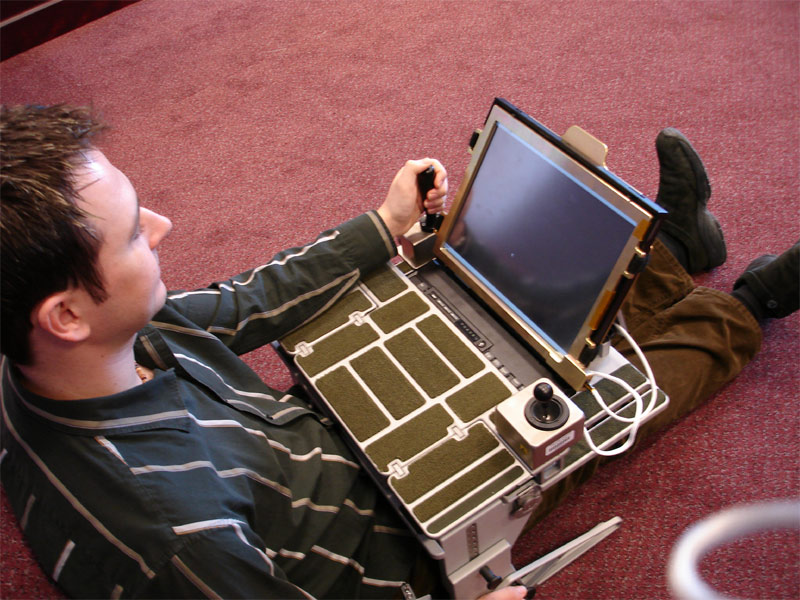Perceptual Motor Deficits in Space (PMDIS)
Stresses associated with living in space, such as space sickness, sleep deprivation and heavy workloads, are primarily responsible for deficits in the ability of astronauts to perform fine eye-hand coordination tasks, according to a study sponsored by the Canadian Space Agency (CSA).
The study, called Perceptual Motor Deficits in Space (PMDIS), also found that astronauts' bodies must be restrained while performing fine motor movements but arm restraints are not necessary.

The National Aeronautics and Space Administration (NASA) Astronaut Suni Williams performs the PMDIS experiment on the International Space Station (ISS) in December 2006. (Credit: NASA)
According to principal investigator, York University neuroscientist Barry Fowler, the experiment does not support the predominant scientific theory that fine motor performance deficits are caused by the effects of microgravity on the balancing (vestibular) system in the brain. He believes his findings are "pretty definitive-I don't think there's any evidence for the microgravity hypothesis."
He argues that the key to reducing these problems in space is pre-flight training and "reasonable schedules" during missions. The ISS is a "closed stressful situation where all sorts of things can be happening at once. You need to train people to pace themselves and focus on one task at a time. The more you train, the less outside stresses will have an effect."
The experiment was done by Space Shuttle astronauts working on the Space Station. Subjects were required to tap targets on a computer screen with a stylus and move a cursor between targets with a joystick. Another test involved multitasking (performing the two previous tasks while responding to auditory tones by pressing a button).
Previous studies showed that astronauts are impaired while performing aiming and tracking tasks in space but scientists weren't sure why. The prevalent theory was that the vestibular system, which is known to be affected by microgravity, sends signals to other parts of the brain that control fine motor performance and cause performance deficits in the week or so it takes the brain to adapt to microgravity.
However, Fowler said his study indicates that "those signals aren't sent or they don't affect the motor system."
If the microgravity hypothesis were correct, his tests should have revealed performance impairment in both the stylus and the joystick tasks. Instead, he found no effect in the stylus test and a small effect in the joystick test. The multitasking tests that involved responding to tones also reinforced support for the stressor theory, Fowler said; such dual tasks (similar to using a cell phone while driving) reveal how stress distracts attention.

Space Shuttle Discovery as seen from the ISS during docking, a very complex manoeuvre. (Credit: NASA)

Precise coordination is important to many tasks astronauts perform, such as operating the Canadarm controls. (Credit: NASA)
In fact, real-life stresses actually caused Fowler to lose data when one subject was distracted by an upcoming high-priority task: helping a crewmate prepare for a spacewalk.
"You can imagine the pressure. It was a perfect example of how difficult it can be to not think ahead to your next task."
Fowler believes that the large effects on motor performance seen in many previous experiments like this were largely the result of subjects floating in microgravity. All his subjects wore waist restraints to anchor their bodies. Some also had additional arm restraints, but he was surprised to find that this produced little improvement in their performance.
He concluded that "restraining the trunk is sufficient to eliminate the body instability issue."

To study hand-eye coordination in space, astronauts perform tests. Derrick Piontek of Bristol Aerospace demonstrates a test to click targets with a joystick (Credit: York University)
Fowler's work was supported by the CSA's life science program, which has a mandate that includes improving the understanding of microgravity effects on human physiology. Louise Beauchamp, CSA's mission manager for PMDIS, said this research might also have operational implications by influencing the design of workstations on future spacecraft.
Fowler said his findings have other implications for long-duration missions. For example, spinning astronauts in a centrifuge to create artificial gravity has been considered to counteract the physiological effects of microgravity. This could have a negative effect if microgravity significantly influences the brain's control of fine motor performance, but Fowler's research suggests this isn't a problem.
"You can spin them and not have to worry about adaptation effects on fine motor performance."
However, he noted that future long-duration flights to the moon or Mars will create many new environmental stressors. Crews will be isolated in a closed, hazardous environment for long periods and will have limited contact with Earth.
"It's a whole different ball game," he said.